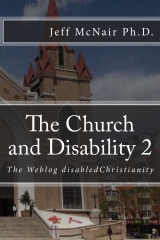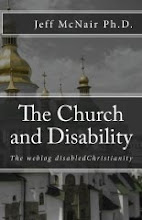Go here to read from the father's blog as to why they did the procedure.
Here is another comment from "Not Dead Yet" website.
The American Association on Intellectual and Developmental Disabilities prepared the statement below in relation to this whole issue. It is a very interesting response. I will comment my self in a future blog.
McNair
(fcbu)

Unjustifiable Non-therapy: A response to Gunther & Diekma (2006), and to the issue of growth attenuation for young people on the basis of disability
From
The Board of Directors of the American Association on Intellectual and Developmental Disabilities
As leaders of the American Association on Intellectual and Developmental Disabilities, the oldest multidisciplinary association in the United States representing professionals within the field of intellectual and developmental disabilities, we have great sensitivity to the concerns facing parents of children with profoundly disabling conditions. They indeed face many extraordinary challenges as they strive to raise their children, and they should be provided with the supports and services they need to ensure that their children, as any others, have opportunities to achieve all that life has to offer. Naturally, these services and supports include medical and habilitation therapies. We as a society should be supportive of innovative approaches to treatment, but we should also demand a thorough evaluation of potential benefits and balance these against carefully considered risks.
Gunther and Diekema1 have described a controversial intervention they provided to Ashley, a 6-year-old girl with profound and multiple impairments, which they refer to as “growth-attenuation therapy.” This intervention, approved and apparently promoted by the parents, consisted of high doses of estrogen to bring about a permanent attenuation in her size. Together with a hysterectomy and removal of both breast buds, the intention was to minimize the likelihood of a future out-of-home placement by maximizing the future comfort of this child and
ensuring a manageable care-giving burden for parents who wanted very much to maintain their daughter in their loving environment.
The ultimate and worthy goal in this case was to ensure a higher quality of life for Ashley through the avoidance of an eventual placement outside of her family home. As individuals and as an organization, we endorse policies and actions that help families to rear their children with intellectual and other developmental disabilities at home, nurturing their capabilities as well as coping with their impairments. We applaud the efforts of the many caring professionals who are engaged in providing extraordinary care to children with intensive and pervasive support needs and who continue to meet those needs throughout their adult lives. We also recognize the many challenges faced by physicians as they weigh with families the benefits versus costs of various treatment options and struggle with the complex ethical concerns that can arise. Gunther and Diekema, as well as Brosco and Feudtner2, discuss some these issues in the context of growth-attenuation therapy and seek responses from the field to inform future practice. As the current leadership of the former American Association on Mental Retardation and now the American Association on Intellectual and Developmental Disabilities, we view growth-attenuation as a totally unacceptable option. We share the concerns raised by Brosco and Feudtner, and we will add our own to theirs.
In Gunther’s and Diekema’s judgment, growth attenuation offers reasonable expectation of improved quality of life in this case. However, the history of the medical establishment’s involvement in exactly these types of quality of life issues has, as noted by Brosco and Feudtner, led to the support of some very regrettable past policies (e.g., involuntary sterilization, lifelong involuntary institutionalization). All physicians must recognize that the decisions they make will be colored by their subjective views of the status of their patients. In stating that there will be no significant future improvement from her baseline, Gunther and Diekema reveal that they and their colleagues recognize little potential for growth and development of this six year old child. It is not then surprising that they find it “hard to imagine how being smaller would be disadvantageous to a person whose mental capacity will always
remain that of a young child” (p. 1016). The abundant evidence that all children are able to learn and that the cognitive capabilities of children with severe motor impairments can be grossly underestimated were not mentioned, and while we do not pretend to be as familiar with this situation as the treating physicians, we think that extant case histories of people with cerebral palsy incorrectly diagnosed as having profound mental retardation should be recognized and discussed.
Brosco and Feudtner questioned the efficacy of the procedures described by Gunther and Diekema, indicating that there is no guarantee that growth attenuation and hysterectomy will effectively delay out-of-home placement. We agree. Further, because the future development of any six year old child will depend on many factors, the medical, social and programmatic needs of the adult Ashley will become cannot be anticipated with certainty. Over recent decades, the principle has been firmly established that an ever-improving future for individuals with extensive impairments is achievable, and in fact there may be adult programs evolving that will offer these parents options they are not now able to consider.
Brosco and Feudtner next noted that risks of harm from this “heavy-handed” manipulation are unknown for this population, and this is an issue that begs for further amplification. Estrogen has hugely important actions. Even a cursory search of the literature shows that it influences things as wide ranging as immune system function and bone growth3 (e.g., Weitzmann and Pacifici, 2006), neuroprotection4 (e.g., Bryant, Sheldahl, Marriott, Shapiro and Dorsa, 2006), and hair follicle physiology5 (Ohnemus, Uenalan, Inzunza, Gustafsson and Paus, 2006). Further, estrogen is metabolized within the central nervous system throughout life, and the negative effects of its depressed bioavailability on aging are well documented. Thus, this artificial manipulation may have many unforeseen consequences, and while optimism has its place, there is ample reason to suspect that some of these consequences will be deleterious.
Brosco and Feudtner discussed the precedent setting potential for growth attenuation that can lead to misuse, and that the intervention does not really address the core problems faced by families and our society regarding services and supports to affected individuals. These are additional excellent points with which we concur. However, they seemed to accept two critical assumptions that we do not. First, in discussing the potentially detrimental effects of growth attenuation, they argue that imposition of small stature might not be a concern if we truly accept the position of disability rights advocates that there is value in every human life and that the worth of a person goes beyond physical appearance. We certainly view people with disabilities as valued members of our society, but we fail to see anything in the disabilities rights movement to justify imposing constraints on anyone’s development. To argue this point grossly misrepresents the views of the disability community and turns logic on its head.
Second, Brosco and Feudtner seemed to implicitly accept the idea that growth attenuation is in fact a type of therapy. We question this critical premise. Given that therapy is intended to address a condition of a patient, the target in this case would have to be the growth and maturation expected as a consequence of Ashley’s normal development. While there are many other treatments that target aspects of physical appearance, these seem qualitatively different from the present case. Although the closest parallel would be the past exposure of tall young women to high doses of estrogen to limit their height, we see this as a considerable stretch. It seems a bit desperate to refer to a practice that fell out of favor years ago (and would be viewed with extreme skepticism today) in defending these procedures, but even in those past cases the intervention was provided with the assent of the patients and to address specific desires.
Clearly, assent was not obtained from this child, and there was no way to assess her willingness to have her body altered irreversibly. Brosco and Feudtner argued persuasively that growth attenuation has to be considered a procedure that has unknown risks and permanent consequences.
Because there was no urgency in this case, a very substantial burden of proof of benefit should have been imposed before moving forward. We see no such evidence of benefit, and despite description of a committee review process (apparently for future cases), there was no mention of including an independent legal advocate for the child or any other professional with explicit expertise in disability rights and autonomy, nor was it apparent that anyone participating in the process would be knowledgeable about the ever expanding options for in-home supports and services. The lives of parents of children with severe disability are profoundly affected, and these individuals are asked to shoulder exceptional responsibilities for care-giving. They should be supported as they strive to meet the extraordinary needs of their children, and we as a society must acknowledge and value their efforts. We must provide them with the supports and services they need to succeed in what Brosco and Feudtner rightly refer to as their “most admirable of undertakings.” However, growth attenuation of their children should not be included as an option. Under our law, parents are vested with the responsibility for making health care decisions for their minor children, but parental prerogatives are not absolute. Children have their own distinct rights and protections afforded them as individuals established in ethical principles and legal statutes. These rights should be of central relevance in the current situation, yet they did not seem to receive the attention they deserved.
With a damning combination of uncertain benefits and unknown risks, growth attenuation as described by Gunther and Diekema is bad medicine, but this practice has even more troubling implications. By extension, if weight ever becomes a difficulty due to age-associated loss of strength for the parents (rather than obesity of the child), then the rationale would suggest that bariatric surgery or severe restriction in caloric intake would be a form of therapy. If that proves insufficient, the goal of reducing the size of the child could be addressed by “amputation-therapy,” justified by the fact that the patient would never be ambulatory in any event.
Should the child develop behaviors that increased the stresses of care-giving, then it should be perfectly acceptable to prescribe whatever dosage of psychoactive medication would be necessary to bring relief to the caregivers.
It seems painfully obvious that medical practice for an individual can rapidly degenerate if the anxieties of the parents regarding as yet unclear future issues replace the medical best interest of the child as the primary focus, even with the noblest of intentions of all parties involved. We see an enormous potential for abuse here, and given the well-documented history of mistreatment, neglect and devaluation of this population, we are stunned and outraged by the very fact that the relative merits of growth attenuation could, in 2006, be a topic for serious debate in this forum. As described by Gunther and Diekema, it distorts the concept of treatment and devalues the patient’s personhood. While references to slippery slopes should be made with great care, we believe that this practice, if judged acceptable, will open a doorway leading to great tragedy.
This door is better left closed.
AAIDD Board of Directors:
Hank Bersani, Jr. PhD, President
David A. Rotholz, PhD, President-Elect
Steven M. Eidelman, Vice President
Joanna L. Pierson, PhD, Secretary/Treasurer
Valerie J. Bradley, Immediate Past President
Sharon C. Gomez, Member-At-Large
Susan M. Havercamp, PhD, Member-At-Large
Wayne P. Silverman, PhD, Member-At-Large
Mark H. Yeager, PhD, Member-At-Large
Diane Morin, PhD, Canadian Member-At-Large
Michael L. Wehmeyer, PhD, Member-At-Large
Bernard J. Carabello, Presidential Advisor
M. Doreen Croser, Executive Director
References
1. Gunther D, Diekema, D. Attenuating growth in children with profound developmental disability: A new approach to an old dilemma. Arch Pediatr Adolesc Med. 2006; 160: 1013–17.
2. Brosco J, Feudtner C. Growth attenuation: A diminutive solution to a daunting problem. Arch Pediatr Adolesc Med. 2006; 160: 1077–78.
3. Weitzmann, M., & Pacifici, R. Estrogen regulation of immune cell bone interactions. Ann N Y Acad Sci. 2006; 1068: 256-74.
4. Bryant, D., Sheldahl, L., Marriott, L., Shapiro, R., & Dorsa, D. Multiple pathways transmit neuroprotective effects of gonadal steroids. Endocrine. 2006; 29: 199-207.
5. Ohnemus, U., Uenalan, M., Inzunza, J., gustafsson, J., & Paus, R. The hair follicle as an estrogen target and source. Endocr Rev. 2006; 27: 677-706.











4 comments:
I feel sympathy for the parents. They are probably exhausted. Please keep in mind that many of these parents don't have any help. From sun up to sun down their whole day revolves around this one child. No one is perfect. I agree that this should not have been the result to this situation. If this attrosity is taking place today imagine what is coming up in our future. perhaps we are going back into history instead of forward? I think this is another reality check how much is needed for children born with dissabilities. Parents need help. They are desperate for help. It is a rare sight for someone to volunteer to help with parents. No. Of course not. Its the opposite in almost all cases. You can barely get paid help. And lets face it, these parents have enough financial burdens. This should be heard as a cry for help. My God Bless this couple.
As a 58 year old adult with cerbral
palsy I was appalled when I heard
of this little girl. Doctors told my parents that I would never walk,
or talk or etc... Parents need
support by all those around them,
but they also need to be told that
doctors are not Gods. Doctors can
can only give a prognosiss to the
best of their knowledge.
We are left with a deep question
that only philosophy and theology
can address - what is the innate
value of a human being? If we base
all of our calculations on the
limited facts of science, most of
us can be deemed disposable at some
point.
Herb Beatty II
This is an immensely difficult problem
I am an advocate for the inclusion of people with disabilities in our church community
and I am a parent of 2 children with Fragile x
I want in every way to validate the life of every person...that is a minimal requirement of being a Christian
but so few Christians take this beyond a statement of faith
seldom does it go beyond, into an action of love
the parents want to care for this child
they don't receive the help they need to do so adequately
what do we do?
let them suffer helplessly while demanding they suck it up and get on with lifting a 140 lb body in and out of a daily bath?
dealing with menstrual fluids and waste and urine and vomit and blood and tears
being exhausted to the point of breaking
beginning to resent the burdens and responsibilities yet loving the source of the burden
I sympathize with the parents.
They want to love this child for their lifetimes.
if our society, our communities and our churches don't lift a finger to help, then how can we make any judgement on this?
how can we make any judgement on abortion either if our churches love the foetus but couldn't (in practical and real terms) 'care less' for the delivered child and it life time of high unending needs?
How can churches stay inactive and uninvolved and still feel they have the right to tell the families how to live and suffer and die?
Anon
I love your comments
they are right on
Herb \you sound like an amazing person
I'd love to know more about your story
do you have a blog or have you written about your experiences?
You sound like someone our churches and our society need to hear more from
God Bless you
Post a Comment